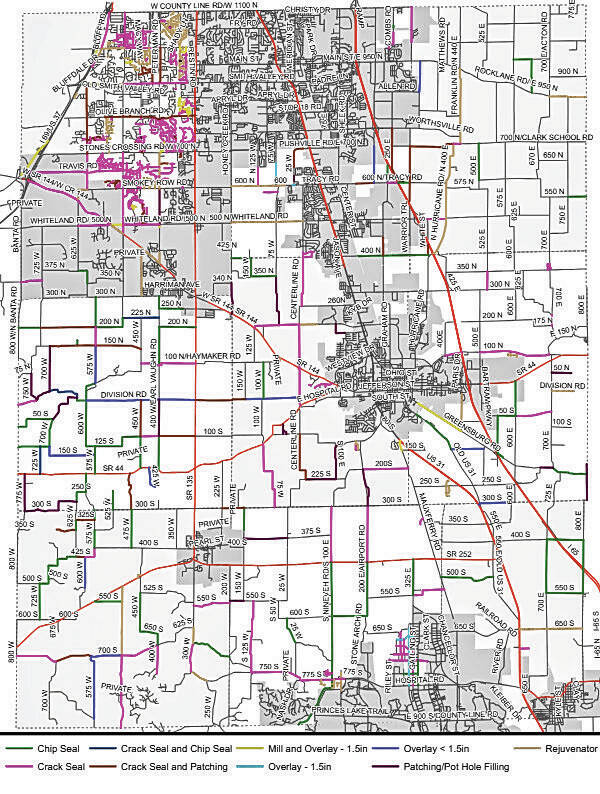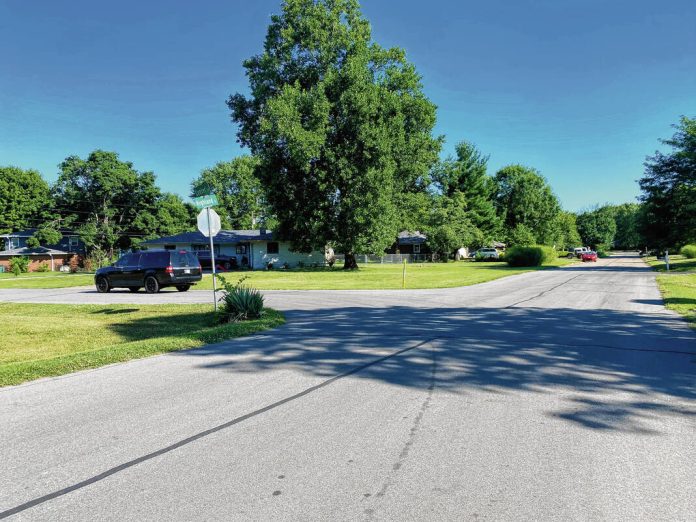Hundreds of road segments across Johnson County are getting nearly $3.9 million worth of maintenance this year.
The Johnson County Commissioners approved the highway department’s 2024 road maintenance program in June, which brings different kinds of road work to all corners of the county. The approximately $3.9 million in work includes chip and crack seal, patching, mill and overlay, pothole filling and rejuvenator treatments.
A majority of the road work will be done in White River Township, which has most of the unincorporated population. Work is also planned in areas through the county’s other eight townships.
Some roads that will have work done on its segments include Old U.S. 31, County Roads 144, 200N, 500N, 500W, 700S, 700E, and 800E, along with Hurricane, Franklin, Rocklane, Division, Centerline, Hopewell, Mauxferry, Greensburg, Nineveh, Graham, Combs, Five Points, Fairview, Peterman, Morgantown, Smokey Row, Mullinix, Travis, Olive Branch, Smith Valley and Bluff roads. A few subdivision streets in Needham and streets in the Johnson County Park will seek work as well, county documents show.
Many subdivisions across White River Township will also see road work including Hunters Pointe, Carefree, Woodland Stream, Clearview Heights, El Dorado, Waters Edge, Raintree Village, Kensington Grove, Hickory Stick, Willow Lakes, Willow Lakes East, Shadow Ridge Village, Southwind Estates, Windsong Estates, Copperleaf Preserve, Bradford Place and Eagle Trace.

To determine which roads need work, the county highway department assesses road conditions. Employees assess them by driving them to determine deficiencies and give them a PASER rating. The score PASER is based on the deficiencies that are visible on the pavement’s surface, said Daniel Johnston, county highway engineer.
When deciding which roads will get work they look at PASER to fix existing road problems, as well as prevent new ones by doing preventative maintenance such as crack sealing. Other key considerations include funding availability, how much work can be done of each treatment type, material and equipment availability, and weather, he said.
“The bottom line goal is to determine how to best use the funding we have available to extend the life of the roads in Johnson County,” Johnston said. “So it’s this balance of, we know which roads need maintenance … we know which roads have maintenance needs but we only have X amount of dollars.”
The road maintenance program is separate from Community Crossings grants, a state matching grant program for road work in communities.
This year’s total of $3.9 million is on par with past years of the maintenance program, Johnston said. It is financed through monthly state distributions from gas taxes, which is how the department gets the majority of its funds.
“Generally, that number kind of remains the same or is [around] the same, so we’re able to predict how much funding we’ll have available to do those pavement (projects), well really to do any type of work,” he said. “Whether it’s part of the 2024 paving list or paying a contractor for a Community Crossings program or buying equipment,” he said.
The department will use in-house crews for some of the projects but they are bidding out a mill and overlay project for 24 different road segments, Johnston said.
One of the biggest challenges for the highway department is balancing what work needs to be done with available finances, he said. There are a few different philosophies for pavement maintenance or asset management, Johnston said.
“There’s a concept of the worst first, which is basically when you do those pavement assessments, you just find the roads that are just falling apart and that’s what you work on, you pour all your money into that,” he said. “Now generally, that would say take that $4 million but only maybe work on two or three roads because a full reconstruction of a road is an extremely high-cost type of work. So, that’s definitely not the philosophy … that we choose and we definitely go with trying to best use the funds to improve as many road segments as possible.”
Johnston said there may be some times when a full reconstruction is needed for a road segment, but it eats up a large chunk of the funding.
Depending on the specific treatment being done, some residents may need to make short-term changes to their daily routines. Some treatments allow vehicles to go around flaggers and flashers and others require roads to be closed only for one day, most likely. If any closure turned out to be a multi-day closure, the department will send out a public notice, he said.
Crews have already started looking at some of the treatment types they are able to do in-house and they will most likely continue working into the fall. Bidding for the mill and overlay project will happen in mid-to-late July, Johnston said.
The maintenance program work is hoped to be finished before temperatures become really cold in late fall, he said.
People can view the map and see a list of the road segments that are part of the project by visiting shorturl.at/BQkn9. One change on the map is that County Road 400W between County Roads 500N and 600N will now be an overlay project instead of a patching project.
The county is currently millions of dollars behind in road work. The Daily Journal will continue to follow road projects and plans to catch up.





